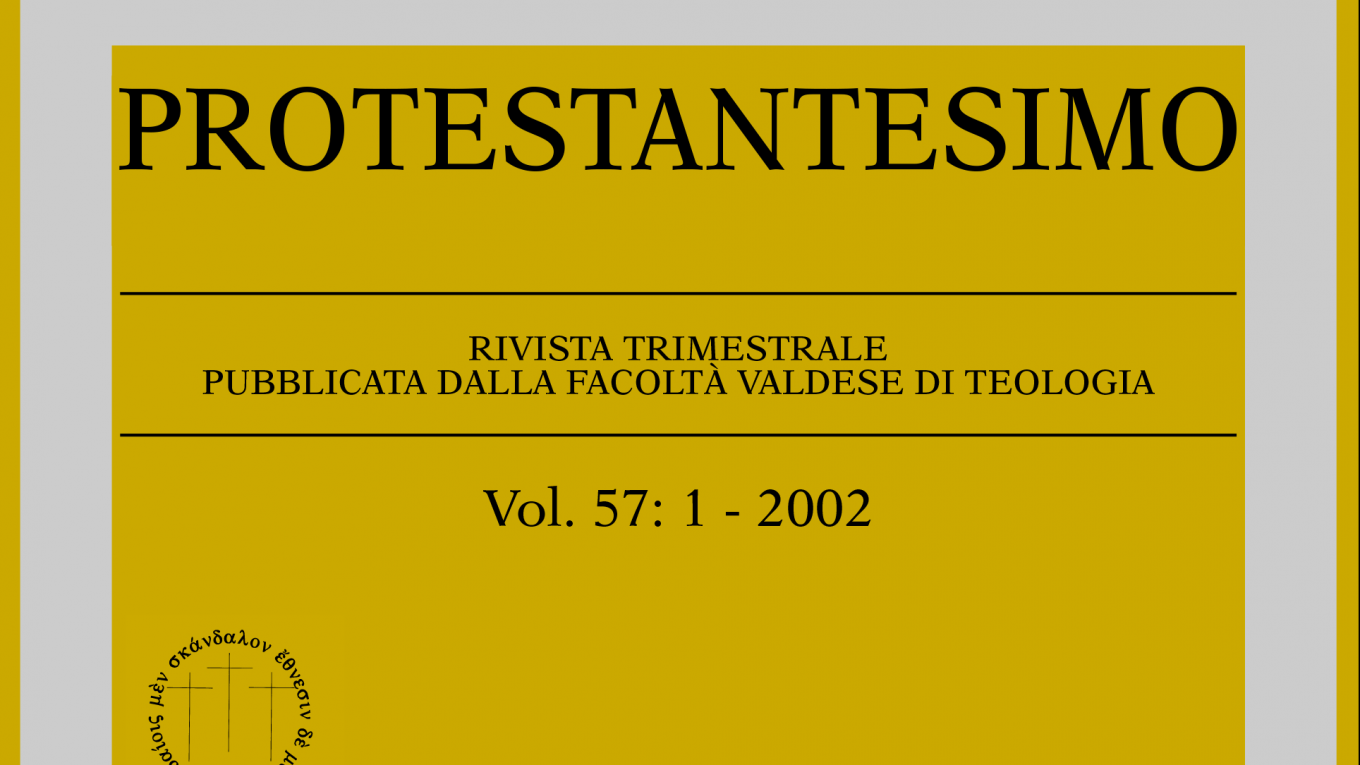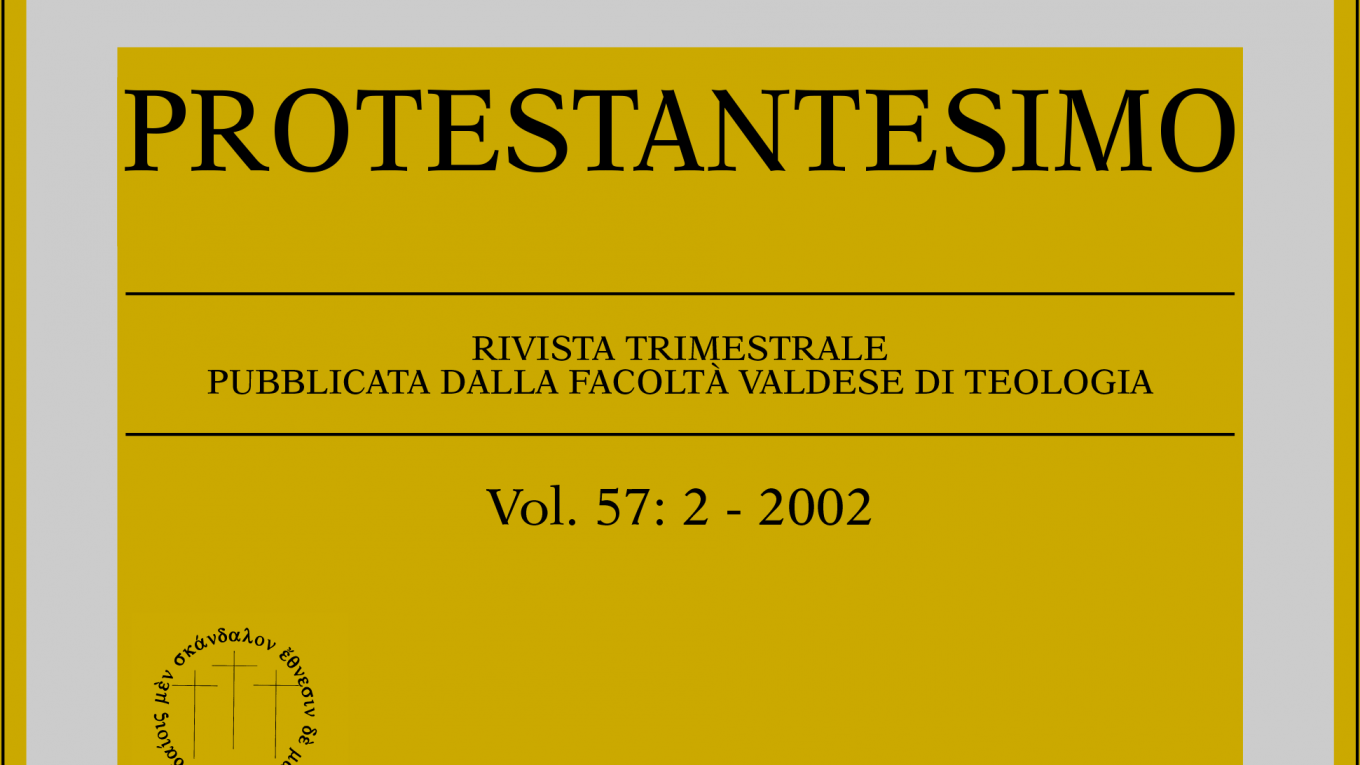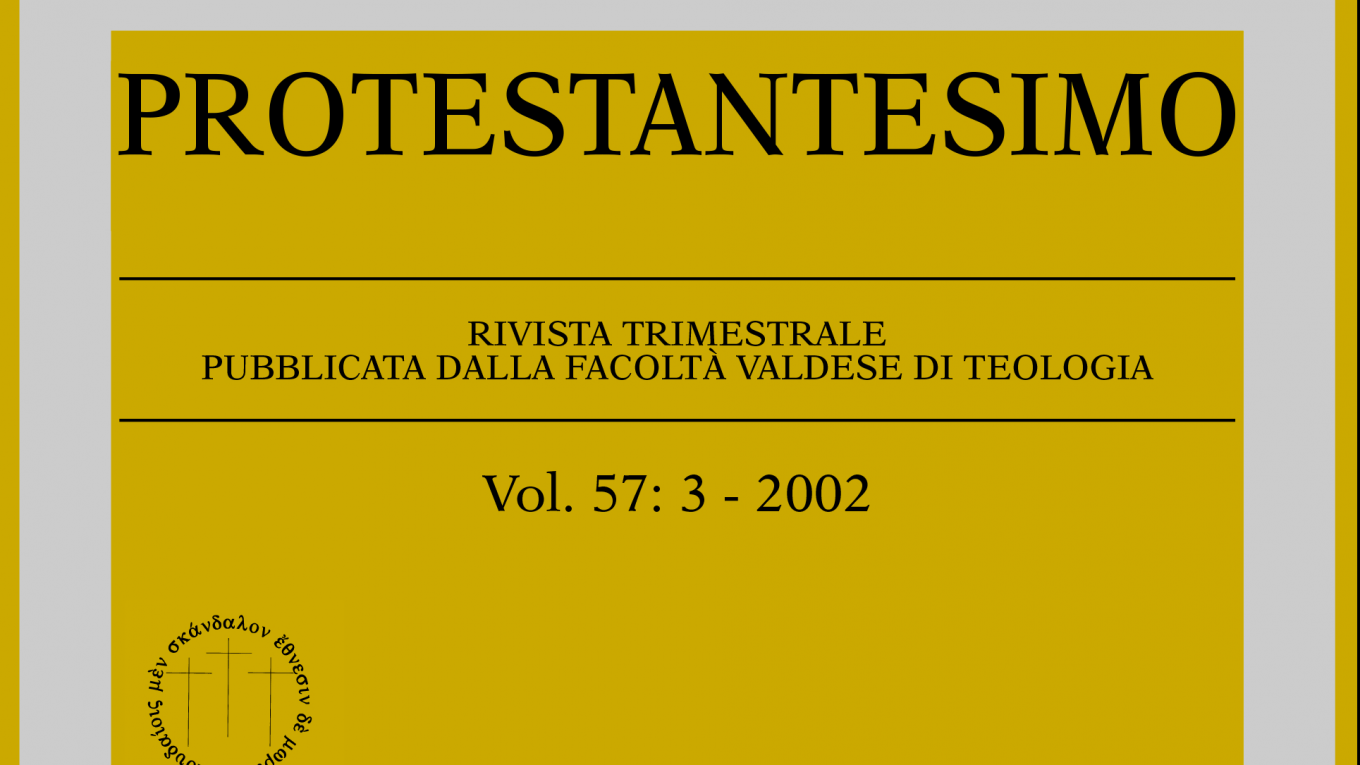abstract vol 70 : 2-3
Eric Noffke, La musica in prosa nel Nuovo Testamento
Si offre qui una panoramica della documentazione antica sul canto nel mediogiudaismo e nel primo cristianesimo. Notando la scarsità di accenni alla mu-sica e, soprattutto, ai testi innici nel Nuovo Testamento, si cerca nel mediogiudaismo la presenza di un contesto utile a dipingere un quadro della situazione. Se il canto era chiaramente importante nel giudaismo settario (i testi di Qumran ci hanno lasciato un numero notevole di inni), le fonti riguardanti le sinagoghe sono poche e vaghe. Sappiamo che nelle comunità protocristiane si cantava, qualche testo neotestamentario può essere classificato come «inno» (Fil. 2,6-11; Col. 2,1-10…) e vari frammenti innici sono identificabili, a dispetto di una cor-rente attuale della ricerca che cerca di sostenere il contrario.
Eric Noffke, Music in Prose in the New Testament
A general picture is given of the old documents on singing in middle Juda-ism and early Christianity. Pointing out the paucity of hints to music and, above all, to the hymn texts in the New Testament, a useful context to illustrate the situation is found in middle Judaism. If singing was clearly important in sec-tarian Judaism (the Qumran texts left a relevant number of hymns), the sourc-es regarding Synagogues are few and uncertain. We know that people sang in the proto-Christian communities, in fact some passages in the New Testament can be classified as “hymns” (Phil. 2,6-11; Col. 2,1-10) and various fragments of hymns can be identified, in spite of the fact that a current tendency tries to sup-port the opposite view.
Jolando Scarpa, Il pensiero musicale in Lutero. Ein feste Burg oltre l’icona della Riforma
Lutero operò un rinnovamento della musica liturgica le cui conseguenze stabiliscono ancor oggi lo stile autenticamente comunitario del canto nella chiesa evangelica. Il concetto della musica sentita come un dono di Dio non fu solo di ordine estetico o teorico, ma si accompagnò a precise istanze teologiche, di ordine pratico, morale e pedagogico. Lutero, pur conoscendo a fondo la pratica musicale, collaborò con eminenti compositori e lui stesso compose il testo poetico e la musica di diversi inni, in uso anche oggi. Un excursus sulla storia del suo più celebre inno Ein feste Burg ne evidenzia l’impatto che ebbe, il favo-re che riscosse nel tempo, le diverse interpretazioni che furono dettate dalle vicende storiche, sociali e culturali dei paesi di lingua tedesca fino ai nostri giorni. La melodia di Ein feste Burg fu anche la fonte inesauribile di ispirazione per molti compositori di musica vocale e strumentale dal secolo della Riforma fi-no ai nostri giorni.
Jolando Scarpa, Luther’s Musical Thought. Ein feste Burg beyond the Icon of the Reformation
The renewal of liturgical music carried out by Luther is the basis of the authentically communitarian style of singing in Evangelical Churches. The idea of music as a gift from God was not only an aesthetic or theoretical concept; it went together with precise theological, practical, ethical and pedagogical is-sues. Although Luther had a profound knowledge of musical practice, he collaborated with eminent composers and was himself the author of the poetical text and music of several hymns, which are still in use today. An excursus into the history of his most famous hymn, Ein feste Burg highlights the impact that it had, the favour it always roused, and the interpretations which were suggest-ed by different historical, social and cultural circumstances in German-speak-ing countries up to our times. The melody of Ein feste Burg has also been an in-exhaustible source of inspiration for many vocal and instrumental music composers from the century of the Reformation to our present time.
Emanuele Fiume, Il Salterio ugonotto: una Confessione in musica
Il Salterio di Ginevra, edito per la prima volta come parafrasi integrale del libro biblico dei Salmi nel 1562, rappresenta un fatto unico tanto nella storia della chiesa moderna, quanto nella storia della musica. Venuto alla luce per vo-lontà di Calvino come innario in lingua popolare in cui la Scrittura fosse unica origine e riconosciuta misura e con una struttura melodica solida, ma semplice e modesta, ebbe una diffusione pressoché globale nelle chiese riformate per tre secoli. Divenuto nella storia un distintivo musicale della fede riformata, il Salterio ha avuto un ruolo particolare nella formazione della cultura moderna, tanto musicale quanto letteraria, senza mai smettere di essere un innario bibli-co e semplice per le chiese.
Emanuele Fiume, The Huguenot Psalter: A Confession in Music
The Geneva Psalter, which was published for the first time as an unabridged paraphrase of the Biblical Book of Psalms in 1562, is a unique phenomenon both in the History of modern Church and in the History of Music. It was produced because Calvin wanted it as a hymnbook in the popular language, in which the Scripture was the sole source and recognized measure, with a solid melodic structure, but simple and modest at the same time. It was in use in nearly althe Reformed Churches for three centuries. It came to be recognized in History as the musical distinctive feature of Reformed faith and it played a special role in the formation of modern culture, both musical and literary, without ever ceas-ing to be a simple hymnbook for churches.
Daniele Cristiano Iafrate, Da Lipsia a Treviso passando per Rio. L’accompagnamento strumentale del canto comunitario
Prendendo le mosse da una lezione tenuta a Roma presso la Facoltà valdese di Teologia, l’autore presenta, appoggiandosi anche a un excursus storico, vari aspetti riguardanti l’accompagnamento strumentale del canto comunitario, fi-no a confrontare due approcci diversi e antitetici: quello della Thomaskirche di Lipsia, con riferimento alla Thomana (scuola di musica con una storia di più di ottocento anni) e quello della chiesa battista Agape di Treviso (dove la musica ha comunque una funzione di grande rilevanza). In parte vengono anche affronta-ti la storia e la morfologia di alcuni strumenti musicali presi in considerazione (in particolar modo l’organo).
Daniele Cristiano Iafrate, From Leipzig to Treviso through Rio… The Instrumental Accompaniment of Singing in the Congregation
Starting from a lecture given at the Waldensian Faculty of Theology in Rome, the Author illustrates, with the help of a historical excursus, various aspects of the instrumental accompaniment of singing in the congregation, comparing two different, opposite approaches: the one of the Thomaskirche of Leipzig, with ref-erence to Thomana (a school of music more than 800 years old) and the one of Agape, a Baptist Church in Treviso (where music has a very relevant function). The history and morphology of some instruments (the organ in particular) are taken into consideration.
Giorgio Tourn, Psaumes et cantiques: una teologia
Riguardo al canto ecclesiastico, le chiese delle Valli valdesi hanno usato sino a metà XIX secolo il Salterio di Ginevra. Il Réveil introdusse nuovi inni e negli anni Cinquanta si sentì la necessità di unificare le due espressioni di fede. Nacque così il Psaumes et Cantiques con 30 salmi e inni provenienti dal mondo risvegliato. La nuova teologia vede in Gesù il Salvatore, la sua presenza nella vita del credente ne determina la fede. Egli vive fra il mondo al quale Gesù lo ha sottratto e il cielo dove lo riceverà. Il rapporto che si instaura fra loro ha carattere personale, Gesù non è solo lo strumento della salvezza ma il mio Salvatore. Nelle successive edizioni si sentirà l’influenza del Revival anglosassone.
Giorgio Tourn, Psaumes et Cantiques: a Theology
The churches of the Waldensian valleys used the Geneva Hymn Book until the middle 19th Century. The Réveil introduced new hymns and in the Eighteenfifties the necessity of unifying the two expressions of faith was felt. This gave birth to Psaumes et Cantiques, with 30 psalms and hymns from the world of the Réveil. The new theology sees Jesus as the Saviour; his presence in the life of the believer produces his/her faith. He/she lives between the world from which Jesus has taken them away and Heaven, which will receive them. There is a personal relationship between the believer and Jesus; Jesus is not only the instrument of salvation, but is also my personal Saviour. In the subsequent editions, the influ-ence of Anglo-Saxon Revival was felt.
Gabriella Ballesio, Il Canzoniere di Agape. La stagione rimossa
Tra il 1969 e il 1973 alcuni campi cadetti di Agape ebbero come tema la rac-colta e lo studio di canti religiosi (e di protesta) tratti da un patrimonio musica-le che andava dagli spirituals alla riscoperta di canti popolari, in vista della re-alizzazione di un Canzoniere che arricchisse il repertorio in uso presso i gruppi giovanili delle chiese evangeliche. L’esperienza produsse tre successive edizioni della raccolta, alcuni spettacoli nelle comunità del Piemonte e della Lombardia e quattro incisioni discografiche; soltanto uno dei canti proposti dal gruppo dei cadetti è stato compreso nell’edizione dell’Innario cristiano del 2000.
Gabriella Ballesio, The Agape Songbook. The Forgotten Season
The theme of some youth holidays in Agape between 1969 and 1973 was to collect and study religious (and protest) songs taken from a musical heritage which ranged from Spirituals to folk songs. The ultimate aim was to create a Canzoniere (songbook) which would enrich the repertoire used by junior groups in Evangelical Churches. As a result, three successive editions of the collection were published, shows were organized in the communities of Piedmont and Lom-bardy, and four records were produced. However, only one of the songs proposed by the juniors has been included in the Hymn Book of 2000.
Sante Cannito, L’innologia protestante contemporanea
L’autore espone alcuni concetti propedeutici tra cui i significati di «periodo contemporaneo» e «innologia protestante», e approfondisce gli ambiti della pre-parazione teologica dei cantautori, dei testi, dello stile musicale e dei nuovi arrangiamenti. Per ognuno di questi punti vengono portati alcuni esempi di autori contemporanei, fornendo brevi cenni storici e proponendo un loro canto (con spartito). Nel terzo e ultimo capitolo, si sottolinea la differenza tra «musica cristiana» e «innologia protestante», in quanto le due definizioni attengono a concetti e ambiti diversi, pur se presenti oggi contemporaneamente nel mondo musicale e editoriale cristiano internazionale. Infine, l’autore conclude riaffermando l’importanza dell’innologia protestante (non solo contemporanea, ovviamente) quale elemento essenziale del rinnovamento liturgico nell’ambito del culto.
Sante Cannito, Contemporary Protestant Hymnology
The Author explains some introductory concepts such as the meaning of “contemporary period” and “protestant hymnology”, and looks into the theo-logical knowledge of singers and songwriters, the words they use, their musical style and new arrangements. Some examples are given for each of these points, offering brief historical notes and proposing one of their songs (with the score). In the third and last chapter, the difference is underlined between “Christian music” and “Protestant hymnology”, because the two definitions cover different concepts, even though they are both present in the international Christian mu-sical world. Lastly, the Author underlines the importance of Protestant hymnol-ogy (obviously not only contemporary) as an essential element of the liturgical renovation of the Service.
Ilenya Goss, Il canto in chiesa, preghiera in musica
Cantare è un’azione tanto spontanea quanto raffinata, tanto estroversa quanto intima, e proprio per questo suo strutturale rapporto con l’espressività e con la bellezza ha suscitato nel corso dei secoli riflessioni contrastanti rispetto al suo esercizio in chiesa, con una storia intrecciata, e non sempre coincidente, con le vicende più generali del rapporto tra culto e musica. Le brevi considerazioni qui proposte intendono portare in luce la profondità che dà rilievo a quanto anche oggi accade nel culto delle chiese italiane legate alla Riforma, in cui la sobrietà del carattere liturgico si articola in pochi misurati gesti, centralità della parola, canto dell’assemblea e talvolta musica strumentale
Ilenya Goss, Singing in Church, a Prayer in Music
Singing is an action both spontaneous and refined at the same time; it is both extroverted and intimate, and because of its structural relationship with expan-siveness and beauty, it has given birth, over the centuries, to opposite reflections vis-à-vis its use in church, its history intertwining but not always coinciding with the more general events of the relationship between the Service and music. The short considerations offered in this article aim at highlighting the depth of what happens during the Service in Italian Reformed Churches, where the simple li-turgy is characterized by few, measured gestures, the central importance of the word, singing by the congregation and sometimes instrumental music.



